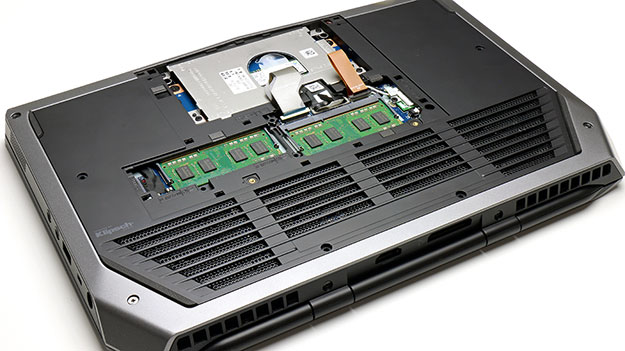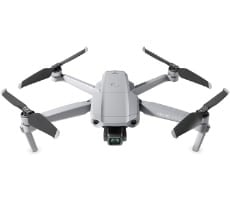While the Alienware 13 with OLED doesn't jump and scream gaming notebook at you like a hell-spawned
Doom demon, it does still don Alienware's signature design language with an illuminated lid and alien head logo, exactly like its predecessor. In fact, it's very similar to the Alienware 13 R2 (sans OLED) save for a couple of key upgraded components. Its external alien skins, however, are identical to
the machine we reviewed in January this year. Frankly, those skins are about due for a refresh as well. Perhaps a real machined aluminum lid is in order other than just well finished and painted high density plastic? We do like the beveled rear corners of the machine, which give it a muscle car sort of look, while trimming its footprint slightly.

 Yeah, it's a Lady Bug, but that's one badass Lady Bug...
Yeah, it's a Lady Bug, but that's one badass Lady Bug...
Regardless, the obvious upgrade with the model we're looking at here, is the new OLED display option, which drops in at a well-balanced 2560X1440 native resolution, with 300 nits of brightness (though it looks even brighter), a typical 1ms pixel response time and a 104% Adobe RGB color gamut reproduction. The two shots above were taken with the machine at full brightness and it's safe to say that the camera doesn't do it justice, even as nice as these pictures are. However, comparing the Alienware 13 OLED side-by-side versus Dell's own fabulous
XPS 15 with its Infinity Edge display, speaks volumes -- check the video on the first page for direct, side by side comparisons.
 A 1ms pixel response time means absolutely zero feathering and ghosting, gaming or otherwise.
A 1ms pixel response time means absolutely zero feathering and ghosting, gaming or otherwise.
The first time you see the
XPS 15 in person, you're struck by how nice the display looks primarily because of its almost non-existent bezel, but also because of it's high contrast, brightness and vibrant colors. And though the Alienware 13 OLED doesn't have the super-thin bezel of Dell's Infinity Edge setup (We can dream though... someday?), you get that same sort of awestruck feeling when you see the AW 13's OLED panel for the first time. The 13.3-inch display's brightness, deep blacks, vibrant saturation and pop are
that impressive. It’s a glossy display but the deep blacks of OLED have a knack of absorbing extraneous light and reflections, while showcasing just vibrant colors and high contrast pop. Then we saw it in flawless, jitter and ghost-free fast moving action and were simply in love. We don't like to use the word "love" often around here. It sounds frivolous referring to a product with such a term of endearment, but regardless, we do in fact "love" this gorgeous display. It's really that nice and no other notebook display we've seen to date compares to its performance and image quality.
Side note: OLED displays do have an increased risk of screen burn, if left on a single static image for too long, more so than IPS. However, the risk is not as significant as you might think, according to our Alienware contacts. They were also quick to point out that Dell does offer full warranty coverage against this, so consumers can rest easy.



Taking a quick walk around the rest of the machine, on the rear edge there’s the Alienware Graphics AMP port and a full sized HDMI port. If you’re not familiar with
Alienware’s graphics AMP, it’s a PCI Express-based breakout box that allows you to install your choice of full sized desktop graphics cards and connect it to the machine for seriously AMPed-up gaming horsepower. It's a kin to the Razer Core for Thunderbolt 3, though Alienware's is a custom solution that offers dedicated PCI Express X4 Gen 3 bandwidth (about 31Gbps). Though Thunderbolt 3 offers 40Gbps bidirectional bandwidth, it is a shared connection versus dedicated. Moving right along, on the right edge, there’s a gigabit Ethernet port, a USB 3 port and a USB type C Thundberbolt 3 port. On the left edge is a power port, a lock port, another USB 3 port as well as microphone and headphone jacks.

The keyboard area of the Alienware 13 is spacious with nice, well defined key caps and a large touch pad. The keyboard is also backlit of course, with Alienware’s usual AlienFX lighting system that lets you customize 8 different zones in a rainbow of colors for your own personal look and pimped-out color scheme. Typing and general use with the keyboard and trackpad are very satisfying. I personally tend towards slightly larger 14-inch notebooks just because there’s more room on the typing deck but the Alienware 13 feels very comfortable with great key travel and tactile response. Overall the machine is rather roomy for a 13-inch notebook but it’s still compact and very portable at just 4.5 pounds. It will travel well on a plane, to the coffee shop, classroom or anywhere you'd take a traditional notebook, and beyond where you'd take the average gaming notebook perhaps.
And yes, you can get at the machine's storage and RAM, to upgrade as you see fit.
Finally, in a crowed market of laptops where most compact machines don't offer access to storage or system memory for upgrades--often times employing board-mounted, hard-wired components--the Alienware 13 OLED offers easy access to both its SODIMM slots and the storage bay. Also, as you can see, the machine supports both M.2 type SSD sticks, as well as standard 2.5-inch SATA drives, simultaneously if you'd like. You could drop in a 2.5-inch standard spinning HDD or cheap but large SATA
SSD for bulk storage, to go with that
NVMe PCIe stick as well.














